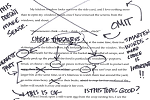
Answering the question
A very common complaint from lecturers and examiners is that students write a lot of information but they just don’t answer the question. Don’t rush straight into researching – give yourself time to think carefully about the question and understand what it is asking.
| Top tip:Set the question in context – how does it fit with the key issues, debates and controversies in your module and your subject as a whole? An essay question often asks about a specific angle or aspect of one of these key debates. If you understand the context it makes your understanding of the question clearer. |
Is the question open-ended or closed? If it is open-ended you will need to narrow it down. Explain how and why you have decided to limit it in the introduction to your essay, so the reader knows you appreciate the wider issues, but that you can also be selective. If it is a closed question, your answer must refer to and stay within the limits of the question (i.e. specific dates, texts, or countries).
Underlining key words – This is a good start point for making sure you understand all the terms (some might need defining); identifying the crucial information in the question; and clarifying what the question is asking you to do (compare & contrast, analyse, discuss). But make sure you then consider the question as a whole again, not just as a series of unconnected words.
Re-read the question – Read the question through a few times. Explain it to yourself, so you are sure you know what it is asking you to do.
Try breaking the question down into sub-questions – What is the question asking? Why is this important? How am I going to answer it? What do I need to find out first, second, third in order to answer the question? This is a good way of working out what important points or issues make up the overall question – it can help focus your reading and start giving your essay a structure. However, try not to have too many sub-questions as this can lead to following up minor issues, as opposed to the most important points.
Generating ideas
Before reading – This is a really valuable stage which many people miss out, but it makes your reading and planning much easier. Before rushing into your reading, note down your initial thoughts about the question – a spider diagram or mind map is good for this.
The kinds of things to note briefly are:
– What you already know about the topic – from lectures, seminars, general knowledge.
– Things you don’t know about the topic, but need to find out in order to answer the question.
– Initial responses or answers to the question – what you think your conclusion might possibly be.
This helps you start formulating your argument and direction for answering the question. It also helps you focus your reading, as you can pinpoint what you need to find out and go straight to the parts of books, chapters, articles that will be most relevant.
After reading – After your reading, it is often good to summarise all your findings on a page – again, a spider diagram can help with this.
Bringing together the key points from your reading helps clarify what you have found out, and helps you find a pathway through all the ideas and issues you have encountered. If you include brief details of authors and page nos. for key information, it can act as a quick at-a-glance guide for finding the evidence you need to support your points later.
It also helps you see how your initial response to the question might have changed or become more sophisticated in light of the reading you’ve done. It leads into planning your essay structure.
Why plan?
- Planning your essay makes it much more likely that you will end up with a coherent argument.
- It enables you to work out a logical structure and an end point for your argument before you start writing.
- It means you don’t have to do this type of complex thinking at the same time as trying to find the right words to express your ideas.
- It helps you to commit yourself to sticking to the point!
You need to work out what to include, and what can be left out. It is impossible to cover everything in an essay, and your markers will be looking for evidence of your ability to choose material and put it in order. Brainstorm all your ideas, then arrange them in three or four groups. Not everything will fit so be prepared to discard some points (you can mention them briefly in your introduction).
Outline what you are going to include in each section:
| Introduction: Address the question, show why it’s interesting and how you will answer it.Main Body: Build your argument. Put your groups of ideas in a sequence to make a persuasive argument. One main point in each paragraph.Conclusion: Summarise your arguments and evidence, and show how they answer the original question. |
Writing a summary – Some people plan best once they have written something, as this helps clarify their thinking. If you prefer to write first, try summarising the central idea of your essay in a few sentences. This gives you a clear direction for working out how you are going to break it down into points supported by evidence. You can then use one of the methods below to write a more detailed plan.
Which planning method suits you?
Spider diagrams / visual plans – These are sometimes known as mind maps. This kind of plan gets all the main ideas down on a page with key words and phrases round the central question. You can then order your ideas by numbering the arms of the spider diagram. This method is flexible and creative, so is good to use first even if you like to order your points in linear form afterwards. Example of a spider diagram.
Bullet points / linear plans – This type of plan lists the main points using bullet points or numbers. It can be a brief outline of the main point per paragraph, or a more detailed plan with sub-points and a note of the evidence to support each point (e.g. source and page no.).
| Top tip:If you know you tend to write too much, cut down the number of individual points in your plan. If you find it difficult to write enough, expand on some of your points with sub-points in the planning stage. |
No plan is perfect, so be prepared for your ideas to change as you write your essay. However, once you have an initial plan it is much easier to adapt it and see where new things fit if your thinking does change.


 WhatsApp us for instant feedback
WhatsApp us for instant feedback